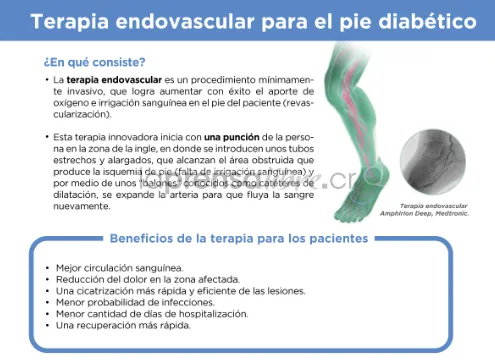The diabetic foot is a complication that affects 50% of people who face this disease, they can even suffer amputation for this cause.
However, there is endovascular therapy that allows 90% of people with this condition to avoid such surgery.
In the country, some 400 thousand people have diabetes, that is, about 10% of the population.
Of these, 200 thousand suffer complications such as the diabetic foot that include the loss of sensitivity, the destruction of the tissues in that part of the body causing ulcers, deformations, infections and as a final result the amputation of the extremities.
For this reason, in the Hospitals San Juan de Dios, Mexico and Calderón Guardia of the Costa Rican Social Security Fund (CCSS) have clinics of the diabetic foot, where multidisciplinary attention is given.
“It is the foot disease in the diabetic patient.Diabetes is a degenerative disease, the longer we have the diabetes, the more possibility that this foot is mainly injured by injuries that can be presented at the anatomy level, that is, the foot is deforming, ”explained Luis Morelli, peripheral vascular surgeon of theSan Juan de Dios Hospital.
In addition, the foot ceases to be functional, because it loses sweating, protective factors such as the perception of injury, sensitivity, also the vascular component that precipitates that the foot reaches its most serious point by increasing the risk of losing it, which occurs when thearteries are clogged.
50% of patients who have the risk of developing the diabetic foot, because they start with a neuropathy, that is, sensitivity damage.
benefits of therapy.
These problems are solved through endovascular therapy and technology, which is performed 10 years ago in the country, saves from amputation to between 85 and 90% of patients.
"We are at a very good point because we have a technology that very few countries have it and that even in Latin America they have it, and allows us to have well controlled and move forward in techniques that we have achieved," he said.
As he explained, with this therapy it is about intervening the patient inside, that is, not to do large surgeries, but work through catheterization, such as in heart conditions.
Through a stab in the groin, they put devices that discourage arteries in a minimally invasive way, with the intention that the blood flow arrives near where they need it that is where the patient has the ulcer.
"Guidelines that are like fine wires that are the ones that pass the obstruction are used, then some balls are used that what they do is open the artery by force," he explained.
This endovascular therapy called Amphirion Deep of Medtronic, is marketed in Costa Rica by the Meditek company.
Prevention
The diabetic foot can be prevented if the disease is controlled, that is, maintaining glycemia levels in a normal range, also avoiding decompensations.
"Among the better medical management, the patient has in the control of his diabetes, his blood pressure, and is a patient who does not smoke or abandon the cigar, he has less risk that he will develop this type of complications," Morelli explained.
For the specialist, if the disease appears, the important thing is the strict monitoring of the patient, that is, that it is constantly reviewed, that has no disease in the arteries or deformity in the foot.
In addition, it should be controlled that it does not have a callus at a specific point of the foot, that it is constantly hurt and that it merits monitoring.
“Once the problem is diagnosed and there are deformities, then special shoes are made so that the little piece is supported normal and is not with support points whereYou should not have them and you are not going to make an ulcer, ”he said.
In addition, if the arteries are obstructed, the problem with surgery can be corrected, if it merits it.
main problem
Morelli explained that the main problem of the diabetic population is that they behave in a different way to smokers or other patients, since the arteries are damaged at earlier ages and in more severe ways.
It is in this part that technology plays an important role, because it allows treatments to be more effective and last over time.
However, it also depends on how the patient takes care of, in someone who does not control can last a year, but a person who fulfills the medical recommendations for years and may not even need a new treatment.
costs
The peripheral vascular specialist said that the devices they use are expensive, but compared to the savings of hospital stay and medicines for the treatment of complications, it represents savings.
“For social security, being able to release a bed early and be able to attend two or three patients in a week instead of one, and that is a benefit, the other is the costs directly related to hospitalization.
And if we value not having to amputate a patient who is still productive, who is working, which is an inability after an amputation that we will have to give the patient for years or months, or the cost of a rehabilitation or a prosthesis”He said.
care
The patient should detect what he is failing, that is, if he is diabetic and consumes high doses of carbohydrates and sugars, it should be educated to change the diet.
"The exercise is extremely important too, the more active the patient is the better prognosis and the less probability that the artery will be obstruct," said the specialist.
Diabetics should consume fiber and proteins, and avoid carbohydrate and sugars diets.


